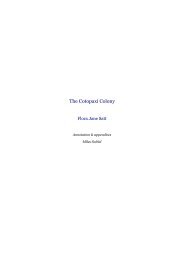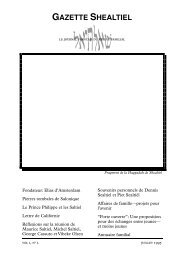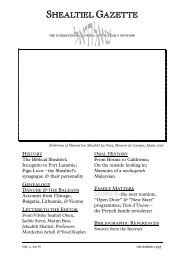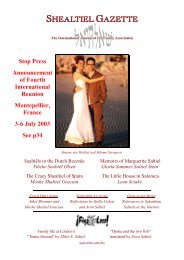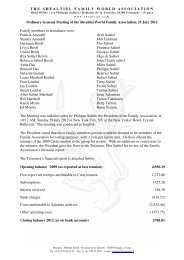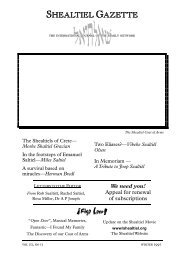please click here for his presentation - The Shealtiel Family Worldwide
please click here for his presentation - The Shealtiel Family Worldwide
please click here for his presentation - The Shealtiel Family Worldwide
You also want an ePaper? Increase the reach of your titles
YUMPU automatically turns print PDFs into web optimized ePapers that Google loves.
Takanot Candia<br />
Thus, as noted above, the 1504 ruling of Emanuel Hen and Isaac ha-Levi reflects a wave of ‘kidnap’<br />
marriages, sometimes with the connivance of the bride.<br />
Likewise, on 28 January 1518, Emanuel Hen and Shmuel del Medigo signed an ordinance that<br />
dealt with an increase in cases of unmarried couples moving in together, or — more often and more<br />
disturbing — of the ‘groom’ moving into the home of the ‘bride.’ Under t<strong>his</strong> harsh ordinance, such<br />
cohabitation was <strong>for</strong>bidden.<br />
Five months later (on 29 June), the same duo grappled with another ‘modern’ habit, the use of the<br />
Mikveh, or public bathhouse. <strong>The</strong> Mikveh had a dual purpose: secular (all members of the<br />
congregation used it <strong>for</strong> personal hygiene) and ritualistic (brides, prior to wedding, ‘purified’<br />
themselves be<strong>for</strong>e female witnesses). It seems that on hot summer nights, the Mikveh was being used<br />
purely <strong>for</strong> cooling off, preventing some brides from putting it to ritual use. <strong>The</strong> rabbis prohibited use<br />
of the Mikveh <strong>for</strong> such recreational purposes.<br />
Del Medigo soon passed on. On 11 November 1519, another member of <strong>his</strong> family — most likely <strong>his</strong><br />
son — signed (again with Emanuel Hen) a new ruling regulating the manufacture, labeling, sealing<br />
and marketing of wine. Jews made wine not only <strong>for</strong> their own use, but also, and perhaps more so, <strong>for</strong><br />
the general population. <strong>The</strong> latter class of wine was not considered kosher. To <strong>for</strong>estall use of t<strong>his</strong><br />
non-kosher (taref) wine by Jews who, knowing it was made by Jews, might naively suppose it kosher,<br />
regulations were issued to distinguish kosher wine by a special seal, coated with tar, and a written<br />
proclamation (in Hebrew) of its fitness to be consumed by fellow Jews. It seems that Shmuel del<br />
Medigo had been part of the team that prepared the ruling; <strong>his</strong> name appears on the ordinance with<br />
the addition of Z’L (‘blessed be <strong>his</strong> memory’).<br />
On 28 January 1520, Emanuel Hen, called “the Sephardi” and “the physician,” cosigned a direct<br />
ruling, something unusual in the Takanot. In it, the religious leadership denounces a local man, who<br />
claimed that he had married a young woman who was engaged to another. <strong>The</strong> man was branded a<br />
liar by the rabbis, who officially declared the woman unmarried, and free to marry. Again, the panel<br />
emphasized the need <strong>for</strong> a quorum of ten to officiate at a wedding ceremony.<br />
- 2 -



